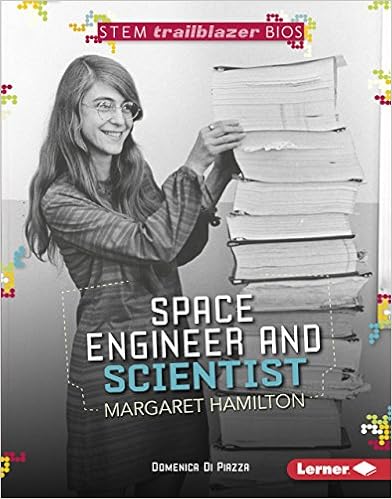
Margaret Heafield was born during a time that girls didn’t do the math and science thing. Not to worry, she loved it and “liked figuring out how to do things on her own.” Margaret was a woman who made things happen and “studied math and philosophy” in college, something unheard of at the time. She admired a woman who not only taught mathematics at Earlham College, but was the chair of the department. Margaret would love to have had a career like that, but there were to be big changes in her life ... huge ones that would take her to places she could have only dreamed about. Margaret married chemist James Cox Hamilton and began a family.
Margaret wasn’t a woman who would stay home like many in that day and age, but rather went into the workforce. In a most unusual move, she “accepted a job at the Massachusetts Institute of Technology (MIT) in 1959.” It was there she began to write software, a field that was quite new. Computer technology was a budding field, one that “very few women worked in.” Soon “MIT’s Charles Stark Draper Laboratory (CSDL) would work with NASA.” Needless to say, Margaret was great at what she did and Draper “hired her to help write computer code for the Apollo missions.” There would be no career as a mathematics instructor, but rather one with the US space program!
One thing Margaret had learned was the fact that “reliable software had to prevent mistakes.” The entire team would be developing software that send Apollo 11 to the moon. The lander “Eagle” would also be heading to the moon, but the computer systems had to be error-free ones in order for a moon landing. Margaret knew that “most errors could be avoided—ahead of time.” Could Margaret and the team write the “Apollo Guidance Computer (AGC) code” to ensure a safe, error-free landing? In this book you’ll learn how the code was written, how she changed the world’s view of computer programming, the Apollo 11 mission, her own company, how she led the field of system and software design, and you’ll learn many other fun and fascinating things about Margaret Hamiliton, trailblazing “space engineer and scientist.”
This is a trailblazer bio about Margaret Hamilton young science and space buffs will enjoy. This large print nonfiction book is prefaced by a table of contents that will set the stage for future nonfiction texts. This particular series of biographies lets the youngest readers know they they too can reach for the stars, both literally and figuratively. Jobs once closed off to either men or women are opening up to those individuals like Margaret who have the talent and drive to succeed. The layout pops with photographs and has numerous informative sidebars that add to the text. In the back of the book is an index, a glossary, source notes, a timeline (1936 to 2016), and additional recommended book and website resources to explore. There are free downloadable complementary resources on the publisher’s website.
Age Range: 7 - 11 years
Grade Level: 3 - 4
STEM TRAILBLAZER BIOS:
Minecraft Creator Markus “Notch” Persson
Mars Science Lab Engineer Diana Trujillo
NASA Astronomer Nancy Grace Roman
NASA Mathematician Katherine Johnson
Space Engineer and Scientist Margaret Hamilton
Astronaut Ellen Ochoa
No comments:
Post a Comment